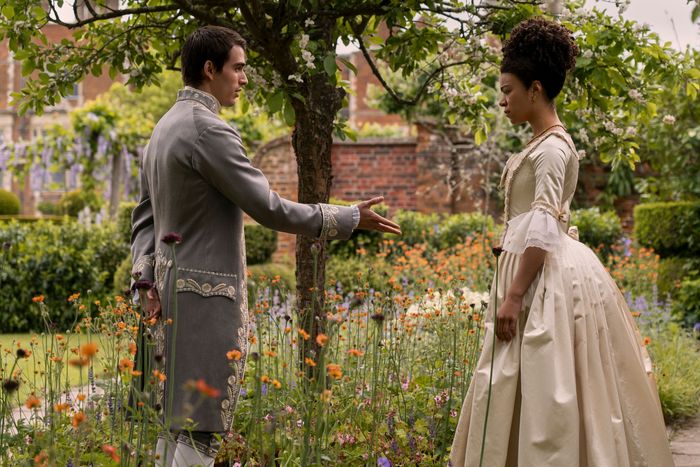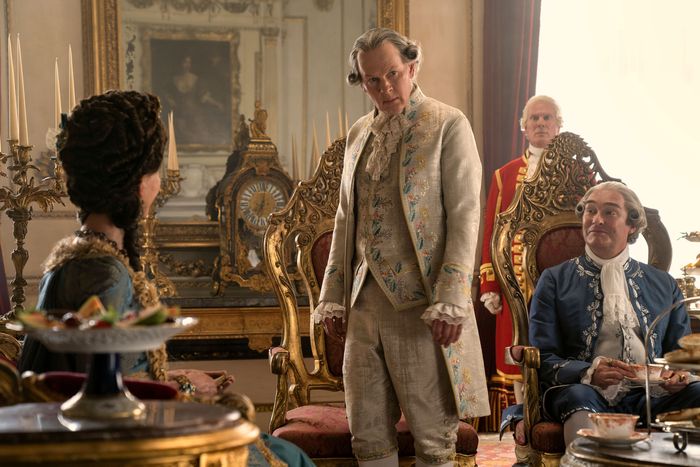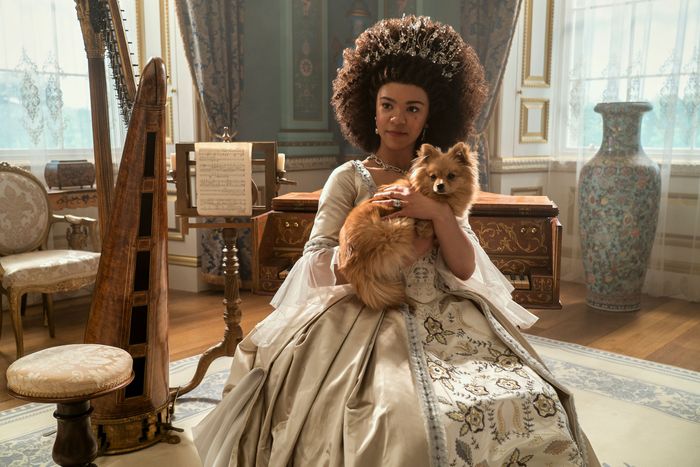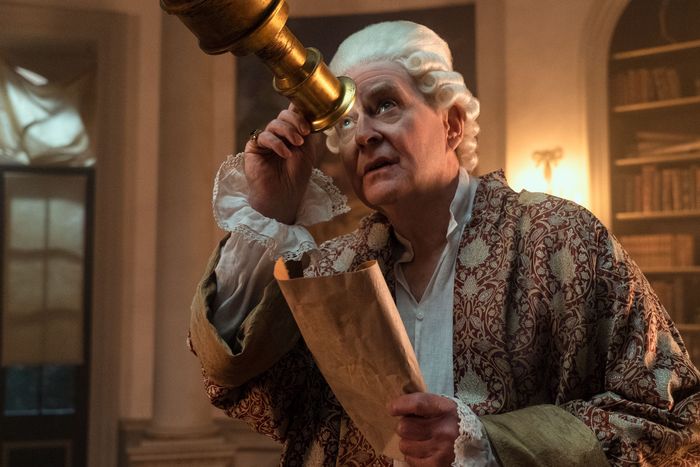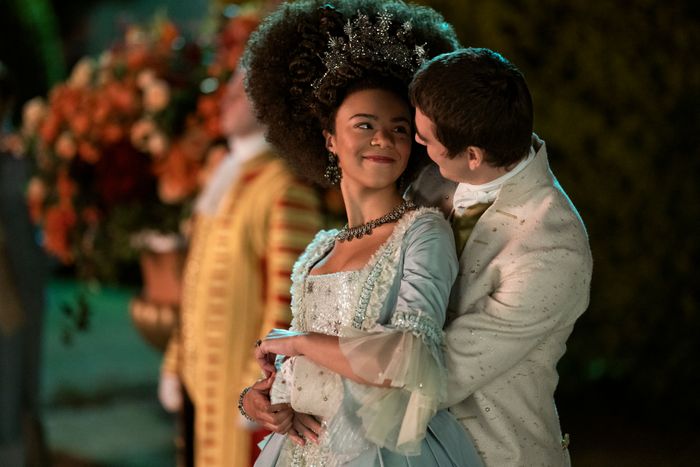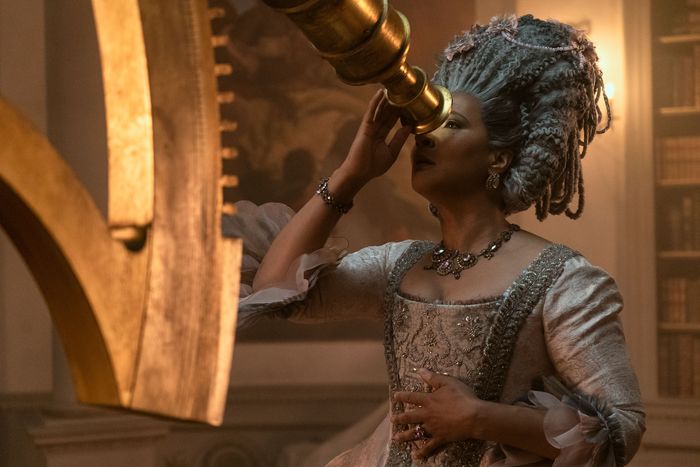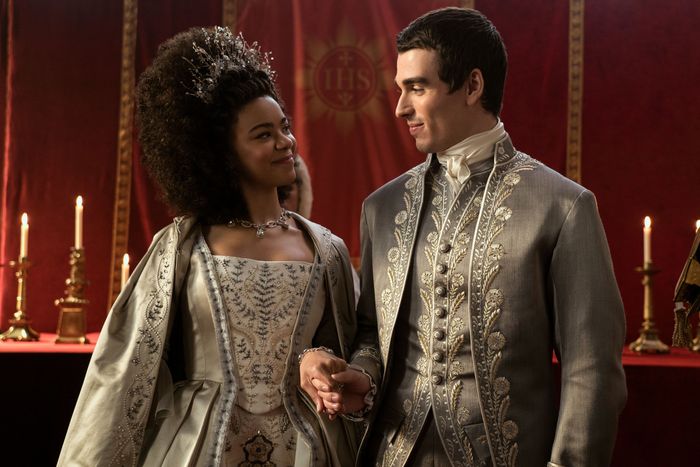
Queen Charlotte opens by telling us, “It is not a history lesson. It is fiction inspired by fact,” a fair warning for history purists, who are encouraged to think of this Bridgerton spinoff as history adjacent. While the reality of King George III and Queen Charlotte does not exactly match the show, recorded history does tell us that they were two people who loved each other very much, had 15 children together, and even slept in the same bed when that was quite outside the norm for their class. The facts of their relationship may not include a societal shift regarding race (unfortunately), but 18th-century England was a gossipy, funny, inventive place, and the more you read about it, the more Queen Charlotte’s world will feel familiar. Here’s what history tells us about the points in the series where fact and fiction meet.
A Black Queen and the Great Experiment
What we see: Charlotte’s “very brown” skin comes as a surprise to George’s mother despite being told the queen-to-be has “Moor blood.” (Charlotte and her brother, the ruler of Mecklenburg-Strelitz in Northern Germany, are played by actors who identify as Scottish Nigerian and mixed-race.) So Princess Augusta scrambles to bring some other Black people to court, kicking off the series’ “Great Experiment” and introducing us to our beloved Lady Danbury and her husband, originally from Sierra Leone.
What history tells us: There is no real evidence that Charlotte or her family were Black or had any even semi-recent ancestors who were (although if you’d like to read about the shaky theory behind this, here you are). While Lady Danbury and the Great Experiment are fictional, England did have a relationship with Lord and Lady Danbury’s home country — it’s just an extremely bad one. In the 18th century, more than 400,000 people were abducted from Sierra Leone and sold by enslavers, many of them to British colonists. When the British did not want to deal with Black refugees from the American Revolution, they sent many of them to Sierra Leone, despite a large number having been born in America.
Bridgerton’s alternate reality has danced around the existence of the British transatlantic slave trade — which wasn’t abolished until 1807, and colonial enslavement wasn’t banned until 1833 — but it’s worth noting that England and Europe have always had Black residents of varying social status. During George III’s reign, Dido Elizabeth Belle, the daughter of a rear admiral in the British navy and an enslaved African woman, came to live in London. Her cousin was a British aristocrat, but Dido herself was not out in society. Other known Londoners of the time included writers and abolitionists Olaudah Equiano and Ottobah Cuguano, as well as composer Ignatius Sancho. To read more about the presence of Black people in Europe, check out Black and British by David Olusoga, Black Tudors by Miranda Kaufmann, and African Europeans by Olivette Otele.
An Unexpected Royal Marriage
What we see: George and Charlotte are made to marry, courtesy of Augusta and Charlotte’s brother, and Charlotte has no idea why the king of England wants to marry her, a princess from a “tiny province in Germany.” He could marry anyone, she says! Her brother tells her there is no good reason, although we learn it’s part of the Great Experiment.
What history tells us: Regarding Charlotte’s befuddlement, I SPUTTERED during this show revelation. “Doesn’t know why??” I exclaimed. (1) George chose Charlotte from a list. Was she initially his last choice on that list? Sure, but he decided correctly in the end, and no one made him. (2) George had to marry a princess, which means no one from England, and a Protestant, so that basically left Germany (and Scandinavia, but we’re not getting into that). George is part of the Hanover dynasty, which is when Queen Anne of The Favourite fame died and left no heirs, despite going through 17 pregnancies (can you imagine), so her second cousin from now-Germany came over and became king. That was George I. His son George II also grew up in Germany, and when George II died, here we have George III. So in brief, no, marrying a German princess was not a surprise.
George III’s Mother and That Man Who’s Always Hanging Around
What we see: In the show, Lord Bute is constantly there, hovering around Augusta and dictating the terms of the Great Experiment. His relationship with Augusta is never clearly defined.
What history tells us: George’s mother Augusta, a.k.a. Princess Augusta of Saxe-Gotha (I’m telling you, the German connection is strong!) married Frederick, the Prince of Wales, who died when George was 13. John Stuart, Third Earl of Bute, was a Scottish peer who was close friends with Frederick and who became George’s tutor, exposing him to “natural philosophy,” architecture, botany, and culture. Bute became prime minister for one year soon after George became king, and while we’ve established the Great Experiment was sadly not real, he did help end the Seven Years’ War. So that’s something! As for his relationship with Princess Augusta, there were lots of rumors at the time, but accounts point to him being happily married with 11 children. Maybe he just liked power. And maybe Augusta was fun to hang out with, who knows.
Shirtless Farmer George
What we see: George spends a good amount of time shirtlessly farming and calls himself “Farmer George.” The implication is he would rather live a quiet life as a farmer instead of leading an empire. Makes sense.
What history tells us: George III did love farming! He, along with many English landowners, took part in an “agricultural revolution,” and his interest lasted at least until his mental health severely deteriorated. (More on that in a moment.) He also did have the nickname Farmer George, but this was maybe meant as an insult to his royal dignity. (I’m not sure he would have taken it as one.) As one source notes, while Marie Antoinette and her court were pretending to be shepherdesses at Versailles, George was “writing about cabbages, crop rotation, and manure, introducing new strains of sheep into England and pioneering modern practices.” George took his duties as king very seriously, but they tended toward the paternal, hence his viewing of the United States as wayward children who needed to be brought back in line (which didn’t work out so well for him).
I dunno about the shirtless part.
Charlotte’s Love of Pomeranians
What we see: After George gifts her a Pomeranian, Charlotte calls it a “deformed bunny” and only comes to love it when she realizes its significance. In later years, we see her constantly with a Pomeranian, similar to the late Elizabeth II and her corgis.
What history tells us: When Charlotte initially came to England, she brought Pomeranians with her. Pomerania bordered the duchy she came from (it’s now Poland and Western Germany), and the dogs were bred there. Fun fact: They are basically miniature sled dogs! Also, they are sometimes known as “Zwergspitz,” which is very fun to say with a pronounced German accent.
George and Charlotte’s 13 Useless Children
What we see: When the series’ “present-day” timeline kicks off, 13 of Charlotte and George’s 15 children have made it to adulthood, managing to produce one legitimate heir between all of them. When that heir dies, Charlotte orders them to shape up, get married, and start reproducing. As the series ends, Charlotte’s fourth son Edward and his wife Victoria announce they’re having a baby (spoiler: It’s eventual country-grabber Queen Victoria).
What history tells us: Charlotte and George had nine sons and six daughters, but their two youngest sons died at ages 1 and 4. (When George’s mental-health condition took hold in force in later years, he would have conversations with these children.) As for the surviving children, one was in a 20-year relationship with an actress and had ten children with her, but none with his legal wife; one became queen of Württemberg; one was king of Hanover when Victoria became queen; one seems like he just kind of noodled around but had some positive social views; and one ended up having three children while married to a German (of course) princess, but they were born after Victoria, so no dice, Prince Adolphus. Of the six princesses, two never married, which is generally attributed to George wanting to keep them at home. Check out Princesses: The Six Daughters of George III by Flora Fraser to learn more about them.
It’s true that only the prince regent had a legitimate heir, who then died. Princess Charlotte was the only child of the prince regent and his hated (by him) wife, Caroline of Brunswick. Her death did indeed spark a panic, as there were no other direct legitimate Hanoverian grandchildren until Victoria was born. (Side note: Charlotte died in childbirth; reproductive health is important!) The eventual Queen Victoria was born two years after Princess Charlotte passed and was her parents’ only child together, as her father died the year after she was born (her mother had two children from a previous marriage). It’s also worth noting that Victoria’s father, Prince Edward, was 51 at the time of her birth, and not the callow youth with poet hair he appears as in the show.
The Madness of King George
What we see: George is exhibiting symptoms of a mental-health condition well before his wedding in 1761, when he is at most 23 years old. This illness recurs with such frequency that he cannot be seen in public, avoids his new wife, and suffers physical torture from Dr. John Monro in an attempt to be “cured.” Charlotte is determined to find out what’s going on and responds to George with care and compassion when she does.
What history tells us: Doctors and mental-health professionals try to be careful now when diagnosing someone directly in front of them, so it’s certainly difficult to armchair-diagnose a king who has been dead for over 200 years, but George III definitely lived with something that resulted in acute mania. The people of his time tried to do their best (after all, he was the king), but they were limited in their knowledge of how to treat him. For a long time, people thought that condition was porphyria, but that has recently been disputed to the point of dismissal. Now it is thought that his symptoms more closely align with bipolar I disorder. His acknowledged manic episodes took place starting when he was 50, and again at ages 63 and 66, with the final episode that triggered the Regency occurring in 1810 when George was 72. However! There was a suspected episode just five years after his coronation. Very little is known about it, but it seems to have been more on the depressive side of manic-depression. There’s nothing to indicate, though, that he had any other major episodes until he was in his 50s.
While it’s unclear how Charlotte reacted to George’s potential first episode early in their marriage, George’s first truly manic episode in 1788 terrified Charlotte, who refused to sleep in the same bed with him for the first time in their marriage and had him locked out of their room. The doctors blistered his scalp and legs and bled him with leeches, but it wasn’t until Francis Willis started treating him that he showed signs of improvement (these two events are not necessarily linked). Willis, like Monro in the series, kept George from Charlotte and demanded total control of his treatment. It does not appear, however, that it was anywhere close to as bad as what the series shows — that’s closer to what previous doctors had done. Willis did use gags and straitjackets at times (now tranquilizers would likely be used instead), but he promoted calm and stopped the emetics and purgatives, as well as the leeches. George was also encouraged to study Latin and do things like take apart and then reassemble watches, which he found helpful. George died of pneumonia in 1820, suffering from dementia, cataracts, and the condition he dealt with in the last decades of his life.
As for Dr. John Monro of Bethlem Hospital, that person did indeed exist! He and his son were asked in later decades to advise on the king’s condition, but there is no evidence they privately treated him. Bethlem is more infamously known as Bedlam and acquired its dubious reputation during Monro’s leadership, where he continued the wisdom of the time, which included bleeding, purging, and vomiting treatments, as well as cold baths (which we do see in the series). This is a time when people were committed for being Methodists. So. Y’know. Not great.
A Royal Love Story
What we see: George and Charlotte meet, immediately marry (at the Royal Chapel in St. James’s Palace), and soon fall in love, remaining as devoted to each other as they can for the rest of their lives.
What history tells us: Excuse me as I weep into my handkerchief, because it’s TRUE, IT’S ALL TRUE. Okay. Well. The basic facts are: George was the first in his family to never take a mistress, and barring some aberrations that were a result of his mental health, from the time of his marriage he exhibited no interest in any other woman besides Charlotte. Early on in his first collapse, he told one of the queen’s ladies that “The queen is my physician, and no man can have a better; she is my friend, and no man can have a better.” They both loved music, books, and theater, and while Charlotte loved botany, George loved astronomy. The only thing he is said to not love about her was her addiction to snuff. More than 20 years into their marriage, George was seen frequently kissing Charlotte on the cheek, and as noted before, even though they had separate apartments, they slept in the same bed for decades. This stopped at the start of the 19th century when George’s symptoms became more permanent and acute. Charlotte was named his guardian and remained so even during the Regency, up until her death in 1818. George died 14 months later.
Bonus Questions
What was the background music during the royal wedding?
Great question! It is “Quartet No IV in G Major,” by Joseph Bologne, Chevalier de Saint-Georges. Saint-Georges was a Creole man of color born in Guadeloupe who moved to France and became a champion fencer and officer of the king’s bodyguard for Louis XVI. This music was an excellent Easter egg, and I was delighted by it.
Did Mozart play for Queen Charlotte?
Eight-year-old Mozart gave his first performance in England at Buckingham House in 1764 when Charlotte was 20. She commissioned six sonatas from him.
Did Queen Charlotte bring the Christmas tree to England?
She did! Her granddaughter Queen Victoria’s husband Prince Albert is typically credited for popularizing the whole “bringing a tree inside the house” thing as a Christmas tradition in England, but Charlotte is the first English royal we know of who had one. Both Charlotte and Albert, of course, came from German duchies, and Christmas trees were seen in Germany starting around the 18th century.
When did we learn the distance from the Earth to the sun?
In one of George’s many looks through the telescope, he tells us that an astronomical event is occurring that will allow the English to calculate the distance from the Earth to the sun. This actually occurred in 1653 by Dutch astronomer Christiaan Huygens (who also invented the pendulum clock!). But he guessed for some of the answer, so history credits Giovanni Cassini in 1672, still well before George’s lifetime. Great job on the pendulum clock, though, Huygens.
More From This Series
- Let Us Bask in the Majesty of Bridgerton’s Music-Box Hair
- Queen Charlotte’s Arsema Thomas Supports Lady Danbury’s Life of Solitude
- Alicia Keys’s ‘If I Ain’t Got You’ Orchestral Version Plucks Heartstrings


